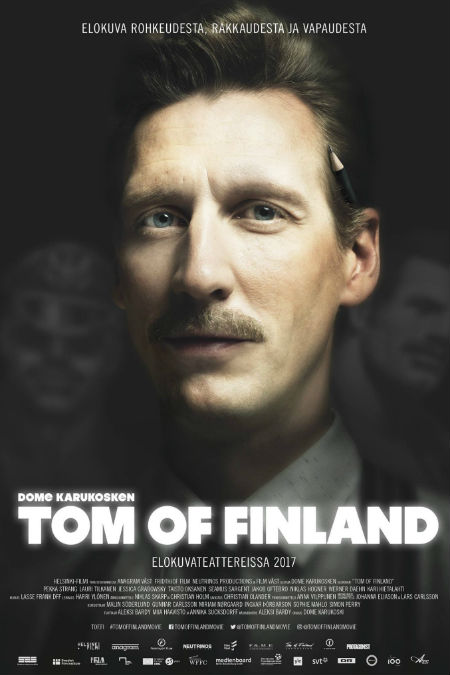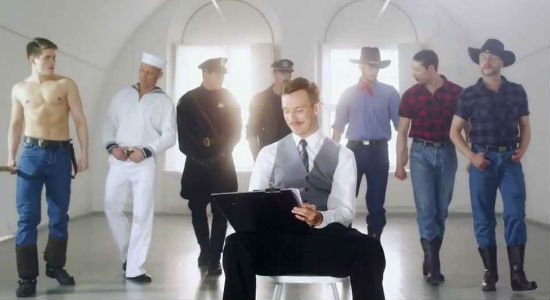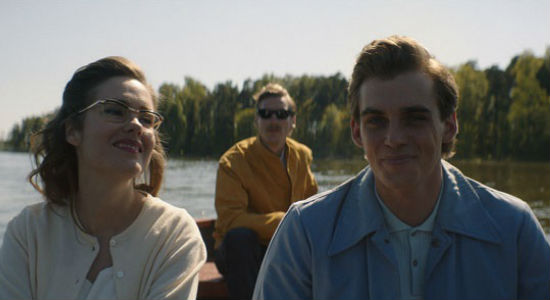
Being repeatedly told that who you are and who you love is some divinely-cursed perversion is guaranteed to take its toll on anyone.
In director Dome Karukoski’s film Tom of Finland, which beautifully brings to life the world’s foremost homoerotic artist Touko Laaksonen, we see how this seemingly unending denunciation affected a man who came to represent a great deal more to gay men everywhere than simply as the creator of fantasy pen and ink drawings important thought they were in their own right).
Through a nuanced narrative which never overplays its hand and moves artfully, and often with great elegance and beauty, between the present day and Touko’s time fighting in World War Two, a period which powerfully affected him, we come to understand that you cannot keep condemning an entire group of people by virtue of your own narrow moral prism and expect them to emerge unaffected.
The Finland of the war and post-war period is one that, like much of the world, reflects a very conservative view of the world, one in which the only real relationship ideal is man and woman, gender is binary and unassailably so, and where anyone who deviates from this established should be treated with the full force of moral and legal condemnation.
There is, of course, no argument to be entered into on this account, so says the moral gatekeepers, and so people like Touko, who practises his sexuality in the most covert way possible, suffering greatly at times for doing so – the “crime” of homosexuality is punishable by police raids, job losses and societal opprobrium, is forced to live unwillingly in the shadows.
In such a repressed and morally authoritarian landscape, his only real outlet, apart from “walks in the park” and “pheasant hunting” and an interest in motorcycle riding that has nothing to do with the machines themselves, is his art where he draws men in various homoerotic fantasy outfits and activities.

It is informative that he first begins drawing soldiers, a reflection of his time as an officer in the Finnish military fighting the Russians – his killing of a downed Russian parachutist saboteur particularly affects him – and policeman, who were, more often than not, the architects of society’s harassment and punishment of “deviant” men like Touko.
It is as if by using both these men in his art, which leaves little to the imagination and embodies a freedom that he does not find for many ears outside of his drawings, that he is able to rehabilitate these traumatic experiences in some fashion, much like gay men themselves appropriated the word “faggot” or black people “nigger”.
It is an attempt to restore the balance of power, tipped unfairly and damagingly in favour of the oppressors, and while it doesn’t erase the memory of these painful episodes in his life – the war is a recurrent motif that appears again and again – it does give Touko, who adopts the Tom of Finland less for marketing reasons than to protect himself by not using his real name, some sense of power regained.
And as it turns out, his art comes to inspire many gay men around the world who find far more than just sexual arousal at the hands of men in leather, cowboy outfits and police uniforms.
In fact, as his American business collaborators Doug (Seumas F. Sargent) and Jack (Jakob Oftebro) make clear to him over and over, most especially where he journeys to meet his fans and advance his career, finding a freedom publicly that eludes him in his home country, he had become the inspiration for so many gay men to reject the derogatory labels assigned to them by bigots and to reclaim who they are and who they love as beautiful, worthwhile things.
This impacts Touko, who is amazed that his private art therapy if you like has come to mean so much to so many, so profoundly that he returns to Finland after his first European trip a changed man, willing to hold hands with the love of his life Veli aka Nipa (Lauri Tilkanen) and to get yellow curtains that he has previously derided as only being for hippies.
It’s not exactly dancing in their apartment with the windows open which is what Nipa longs for as a symbol of real freedom, but it is a significant step forward for Touko who increasingly finds his private world becoming his public one.

Being a European production, and not prone therefore to the tendency of Hollywood to wipe all nuance away and build and build to a happily ever after with no complications conclusion, Tom of Finland is not an uninterrupted upward trajectory.
There is the matter of Touko’s sister Kaija (Jessica Grabowsky) who though close to her older brother sees his work as degenerate, sexual smut, not worthy of a true artist – a standing to which they both aspire and one which only Touko attains – and a stain on their family name.
She typifies, painfully close to a home, an attitude that makes Touko’s life hell over and over again, though with less stinging frequency as the decades go by, and which both saps his sense of self and impels him to push forward in defence of who he is and the art he creates.
But as Touko comes to own himself, and gay men everywhere embrace Tom of Finland and his sexually-evocative, life-affirming art, her voice, and that of the smallminded bigots around her, became less and less strident and Touko, Nipa, Doug and Jack are able to finally began to assert who they are without any apologies.
Grounded in some fairly telling and oft-painful memories, and informe dby an understanding of what it is to live in the closet and the glorious exhilaration of escaping it, Tom of Finland is an exquisitely and touchingly well-told story, one that should hearten anyone who has ever felt like they will never truly be valued for who they are.
“a reflection of his time as an officer in the Finnish military fighting the Nazis and then the Russians – his killing of a downed Russian airman particularly affects him”
Finland first fought against the Soviet Union, alone, and then fought a second war against them, this time getting help from Germany. Tom never fight against the Germans. Also the Soviet parachutist was a spy, sent to Finland to do sabotage, that’s why they were killed when caught.